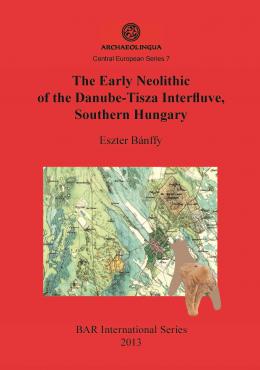The Early Neolithic of the Danube-Tisza Interfluve, Southern Hungary

The Early Neolithic of the Danube-Tisza Interfluve, Southern Hungary
| 19 412 Ft |
| Price |
British Archaeological Series International Series
Budapest, Archaeolingua, 2013
Puhakötés | Paper book
189 oldal, színes és fekete-fehér illusztrációkkal | 189 pages with colored and grayscale images
ISBN 978 1 4073 1212 5
Description
In tune with the growing interest in prehistoric frontier zones in Europe, the present volume focuses on one of these marginal regions, on a white spot in the Early Neolithic of the Carpathian Basin. While the eastern and western areas of this region have been fairly well researched, the dense settlement network of the Körös culture in the heartland of the Carpathian Basin, on the alluvial plain of the Danube, has hardly ever been discussed. The fifty Körös sites identified during field surveys and described in detail, as well as the assessment of an old, unpublished excavation form the backbone of this volume alongside a complex analysis of the landscape and the vegetation, an assessment of the anthropological and archaeozoological remains, as well as various archaeometric studies. The key issue discussed in the volume is the enigmatic behaviour of two neighbouring and genetically related northern Balkanic populations, namely the Körös and the Starčevo communities, which apparently had no archaeologically visible contact with each other. This issue is specifically relevant in the light of the spread of farming towards Central Europe: a process in which Starčevo groups played a decisive role, whilst the Körös groups did not. The southern Danube region in Hungary is one of the key areas where the shift to sedentism occurred and whence it spread towards Central Europe. In addition to a comprehensive summary of our present knowledge and an outline of the possible trajectories of future research, the book also addresses a set of new questions on the Neolithic transition. The author has been studying the cultural, genetic, cognitive and environmental changes in Neolithic for many decades. The other contributors to the volume provide detailed information on a series of related topics.
| |
|
|
1067 Budapest, Teréz krt. 13. |
|
|
|
|
About us
The Archaeolingua Foundation and Publisher is involved in publishing series and standalone publications in the disciplines of archaeology, linguistics, historic sciences and heritage protection for over 25 years.
Learn more
Publishing
We publish both as standalone editions and as a volume of a professional series.
Learn more
Contact us
Archaeolingua Foundation

